These TS 10th Class Biology Bits with Answers 6th Lesson Reproduction will help students to enhance their time management skills.
TS 10th Class Biology Bits 6th Lesson Reproduction
Choose the correct answer.
Question 1.
Identify the correct sequence.
A) Prophase → Anaphase → Telophase → Metaphase
B) Prophase → Metaphase → Anaphase → Telophase
C) Metaphase → Telophase → Prophase → Anaphase
D) Prophase → Anaphase → Metaphase → Telophase
Answer:
B) Prophase → Metaphase → Anaphase → Telophase
![]()
Question 2.
The part that produces the sperm in the male reproductive system
A) Seminal duct
B) Prostate gland
C) Testes
D) Seminal vesicle
Answer:
C) Testes
Question 3.
In plants, the fusion of male gamate with secondary nucleus results in ………..
A) Embryo-sac
B) Endosperm
C) Cotyledons
D) Spores
Answer:
B) Endosperm
Question 4.
Name the body part which have division-less cells.
A) Brain
B) Lungs
C) Kidney
D) Stomach
Answer:
A) Brain
![]()
Question 5.
Identify the mitotic phase shown in the diagram.

A) Prophase
B) Anaphase
C) Metaphase
D) Telophase
Answer:
B) Anaphase
Question 6.
The plant shown in figure ……

A) Potato
B) Vallisneria
C) Strawberry
D) Bryophyllum
Answer:
D) Bryophyllum
Question 7.
The following are the functions of testes during puberty
i) Secretion of progesterone.
ii) Secretion of testosterone.
iii) Development of chorology.
iv) Formation of sperms.
A) (i) and (iii)
B) (ii) and (iv)
C) (iii) and (iv)
D) (i) and (ii)
Answer:
B) (ii) and (iv)
Question 8.
Spore formation is the common method of asexual reproduction in
A) Hibiscus.
B) Tridax.
C) Marigold.
D) Fern.
Answer:
D) Fern.
![]()
Question 9.
Name the structures found in a bean seed shown in the figure.

A) Cotyledon and rad ide.
B) Plumule and cotyledon.
C) Cotyledon and endosperm.
D) Plumule and radicle.
Answer:
D) Plumule and radicle.
Question 10.
Identify the stage of cell division.

A) Prophase.
B) Metaphase.
C) Anaphase.
D) Telophase.
Answer:
C) Anaphase.
Question 11.
Arrange the relevant order of the stages of cell cycle.
![]()
A) 2 → 1 → 4 → 3
B) 4 → 1 → 2 → 3
C) 4 → 2 → 3 → 1
D) 1 → 3 → 4 → 2
Answer:
C) Anaphase.
![]()
Question 12.
This type of vegetative propagation is………..
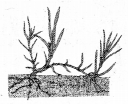
A) Layering
B) Cutting
C) Stolon
D) Corms
Answer:
A) Layering
Question 13.
The number of cells and nuclei present in the Embryo sac of a flowering plant respectively are ………….
A) 7 cells, 8 nuclei
B) 7 nuclei, 8 cells
C) 3 cells, 7 nuclei
D) 3 nuclei, 8 cells
Answer:
A) 7 cells, 8 nuclei
Question 14.
Identify the INCORRECT statement from the following.
A) Testis produce sperms
B) The embryo growing in the mother’s womb has four layers, i.e., Chorion, Amnion, Allantois and Yolk sac.
C) Cowper’s glands are present in female reproductive system.
D) Sperms are motile.
Answer:
C) Cowper’s glands are present in female reproductive system.
Question 15.
Organisms are capable of giving rise to off springs by the process of [ ]
A) Nutrition
B) Reproduction
C) Excretion
D) Circulation
Answer:
B) Reproduction
Question 16.
Sexual reproduction mainly involves [ ]
A) Single organism
B) Only mitotic cell division
C) Formation of gametes
D) Production of identical off springs resembling parent.
Answer:
C) Formation of gametes
![]()
Question 17.
In stem cuttings, a slanting cut is made in the stem [ ]
A) below the node
B) above the node
C) on the node
D) across the node
Answer:
A) below the node
Question 18.
The result of sexual reproduction cannot show the following. [ ]
A) Recombination of genetic material
B) Production of new characters in the offspring
C) Production of identical offspring
D) Occurrence of reduction division before gamete orientation
Answer:
C) Production of identical offspring
Question 19.
The most essential floral organs required for sexual reproduction [ ]
A) Calyx. Corolla
B) Corolla and Androecium
C) Gynoecium and Thalamus
D) Gynoecium and Androecium
Answer:
D) Gynoecium and Androecium
Question 20.
At the time of fertilisation diploid condition in embryo sac is seen in [ ]
A) Egg
B) Synergids
C) Secondary nucleus
D) Antipodals
Answer:
C) Secondary nucleus
![]()
Question 21.
Endosperm nucleus is formed from the fusion of male nucleus (gametes) with [ ]
A) Egg
B) Secondary nucleus
C) Zygote
D) Synergids
Answer:
B) Secondary nucleus
Question 22.
External fertilization occurs in [ ]
A) frog, rat
B) crow, fish
C) snake, fish
D) frog, fish
Answer:
B) crow, fish
Question 23.
Male reproductive system consists of [ ]
A) Umbilical cord
B) Testis
C) Fallopian tube
D) Placenta
Answer:
B) Testis
Question 24.
Seminiferous tubules occur in [ ]
A) Urethra
B) Fallopian tubes
C) Vasefferentia
D) Testis
Answer:
D) Testis
Question 25.
Spermatozoa from seminiferous tubule move into… [ ]
A) Epididymis
B) Vas deferens
C) Vasefferentia
D) Urethra
Answer:
C) Vasefferentia
![]()
Question 26.
After release from follicle the ovum enters into [ ]
A) epididymis
B) vas deferens
C) fallopian tube (or) oviduct
D) uterus
Answer:
A) epididymis
Question 27.
Number of ova released at a time in female human beings is [ ]
A) 4
B) 3
C) 2
D) 1
Answer:
C) 2
Question 28.
Foetus is connected to the wall of uterus of the mother by [ ]
A) placenta
B) umbilical cord
C) fallopian tube
D) epididymis
Answer:
D) epididymis
Question 29.
The organism reproduces by budding is [ ]
A) Paramoecium
B) Euglena
C) Yeast
D) Amoeba
Answer:
B) Euglena
Question 30.
Reproduction is essential for living organisms because [ ]
A) It keeps the individual alive
B) Fulfil the energy requirement
C) Maintain growth
D) Continue the species forever.
Answer:
B) Fulfil the energy requirement
![]()
Question 31.
The sexually transmitted disease which is caused by bacteria [ ]
A) Herpes
B) Aids
C) Mumps
D) Gonorrhoea
Answer:
D) Gonorrhoea
Question 32.
Which of the following method of contraception protects a person from acquiring a sexually transmitted disease? [ ]
A) Spermicides
B) Vasectomy
C) Tubectomy
D) Condom
Answer:
D) Condom
Question 33.
Identify the surgical birth control method in males. [ ]
A) Copper T
B) Oral pills
C) Vasectomy
D) Tubectomy
Answer:
C) Vasectomy
Question 34.
The part of a seed which grows and develops into root on germination is: [ ]
A) epicotyl
B) hypocotyl
C) radicle
D) plumule
Answer:
C) radicle
Question 35.
Fragmentation is a common mode of reproduction in [ ]
A) Algae
B) Fungi
C) Algae, Fungi
D) None
Answer:
C) Algae, Fungi
Question 36.
It is a process in which an unfertilized egg develops into an embryo. [ ]
A) Regeneration
B) Parthenogenesis
C) Fragmentation
D) Budding
Answer:
D) Budding
![]()
Question 37.
Parthenogenesis occurs in [ ]
A) Bees
B) Ants
C) Wasps
D) All
Answer:
D) All
Question 38.
The ability of the organisms to give rise to new individual organisms from their body parts called [ ]
A) Budding
B) Regeneration
C) Parthenogenesis
D) Fission
Answer:
B) Regeneration
Question 39.
Small plants grow at the edge of leaves of [ ]
A) Bryophyllum
B) Dahlia
C) Allium cepa
D) Vallisneria
Answer:
A) Bryophyllum
![]()
Question 40.
This Artificial propagation is used to obtain a plant with desirable characters. [ ]
A) Cutting
B) Layering
C) Grafting
D) Budding
Answer:
C) Grafting
Question 41.
Spore producing plants are [ ]
A) Fungi, Bacteria
B) Ferns, Mosses
C) Fungi, Bacteria, Ferns and Mosses
D) None
Answer:
C) Fungi, Bacteria, Ferns and Mosses
Question 42.
In males production of sperms begin from the age of [ ]
A) 13 or 14 years
B) 14 or 15 years
C) 15 or 16 years
D) 12 or 13 years
Answer:
A) 13 or 14 years
Question 43.
Umbilical cord develops from [ ]
A) Chorion
B) Allantois
C) Amnion
D) All
Answer:
B) Allantois
![]()
Question 44.
The gestation period in human beings. [ ]
A) 280 days
B) 330 days
C) 300 days
D) 260 days
Answer:
A) 280 days
Question 45.
The tree that grows in himalayan mountain is [ ]
A) Sal
B) Cactus
C) Orchid
D) Potato
Answer:
A) Sal
Question 46.
Flower that contain both stamen and carpel are [ ]
A) Bisexual
B) Unisexual
C) Hermaphrodite
D) Multi sexual
Answer:
A) Bisexual
![]()
Question 47.
Who said that plants prefer self fertilisation when they are isolated?
A) Darwin
B) Lamarck
C) Mendel
D) Walther Flemming
Answer:
A) Darwin
Question 48.
After fertilisation the ovary grows and ripens to form [ ]
A) fruit
B) seed
C) bud
D) all
Answer:
A) fruit
Question 49.
Who discovered mitosis?
A) Waither Hemming
B) Theodar Boyen
C) Augustus Weisemann
D) Chartes Darwin
Answer:
A) Waither Hemming
Question 50.
Interphase is [ ]
A) The time of active division
B) It is the period when the genetic material makes its copy
C) It is divided into four phase
D) All
Answer:
B) It is the period when the genetic material makes its copy
![]()
Question 51.
During this phase of mitotic division chromosomes split lengthwise to form chromatids.
A) Prophase
B) Metaphase
C) Anaphase
D) Telophase
Answer:
A) Prophase
Question 52.
Name the part which is asked as a ……….
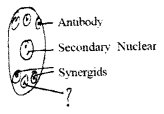
A) Granular cell
B) Polar cell
C) Egg cell SIWdS
D) Hard cell
Answer:
C) Egg cell SIWdS
Question 53.
Aids control projects implementing various programmes like [ ]
A) ASHA
B) Red ribbon express
C) Both A and B
D) ART Centres
Answer:
C) Both A and B
Question 54.
New characters are seen in offspring in sexual reproduction due to ………….
A) Mutations
B) Genetic recombination
C) Cell division in developing embryos
D) Union of gametes
Answer:
B) Genetic recombination
![]()
Question 55.
Production or fusion of gametes does not takes place in this kind of reproduction.
A) Asexual
B) Sexual
C) Conjugation
D) None of the above
Answer:
B) Sexual
Question 56.
In a sexual reproduction of the following group, a large number of spores are formed in special structures
A) Fungi
B) Fern
C) Mosses
D) All the above
Answer:
D) All the above
Question 57.
Epiphytlous Buds are present in [ ]
A) Potato
B) Chrysanthemum
C) Bryophyllum
D) Sugarcane
Answer:
C) Bryophyllum
Question 58.
Success of grafting between two grafts depend upon the formation of ……………….
A) New tissue between the grafts
B) New tissue in stock part
C) New tissue in scion part
D) Secondary tissue in stock part
Answer:
A) New tissue between the grafts
Question 59.
Chromosomal number becomes half in certain types of cells in cell division. This type of cell division takes place in ….
A) Testis only
B) Ovaries only
C) Both
D) All the body cells
Answer:
C) Both
![]()
Question 60.
Melotic division takes place in [ ]
A) Germ cells
B) Somatic cells
C) Zygote
D) All the above
Answer:
A) Germ cells
Question 61.
The first cell formed after the union of male gamete with egg is called ………
A) Zygospore
B) Zygote
C) Zoospore
D) Blastula
Answer:
B) Zygote
Question 62.
Foetus is attached to the uterine wall by [ ]
A) Umbilical cord
B) Amnion
C) Placenta
D) Chorian
Answer:
C) Placenta
Question 63.
Foetus is the name of the embryo from the [ ]
A) Second month of pregnancy
B) Fourth month of pregnancy
C) First month of pregnancy
D) Third month of pregnancy
Answer:
D) Third month of pregnancy
Question 64.
The part of the ovary that release ovum [ ]
A) Fallopian tube
B) Semeniferous tubules
C) Graffian follicles
D) Corpus Luteum
Answer:
C) Graffian follicles
Question 65.
Accessory glands of human male reproductive system includes [ ]
A) One prostrate gland, One cowper gland
B) One prostrate gland, Two cowper glands
C) Two prostrate glands, One cowper gland
D) Two prostrate glands, Two cowper glands
Answer:
B) One prostrate gland, Two cowper glands
![]()
Question 66.
Curdling of milk indicates the increase in number of [ ]
A) Bacteria
B) Virus
C) Fungus
D) All the above
Answer:
A) Bacteria
Question 67.
To obtain a plant with desirable characters, vegetative propagation method to be used is [ ]
A) Layering
B) Grafting
C) Cutting
D) Suckers
Answer:
B) Grafting
Question 68.
Fern leaf which produces spores is called [ ]
A) Sporangium
B) Sporangiophore
C) Sporophyll
D) Sorus
Answer:
C) Sporophyll
Question 69.
Accessory glands in male reproductive system secretes a fluid called semen which helps in [ ]
A) Provide nutrients to sperms to keep have
B) Providing a medium for the movement of sperms
C) Secreting testosterone
D) A and B only
Answer:
D) A and B only
Question 70.
Ovulation is …………..
A) Release of ovum from graffian follicles
B) Release of ovum from fallopian tube
C) Release of ovum from uterus
D) Release of ovum from carpus leteum
Answer:
A) Release of ovum from graffian follicles
![]()
Question 71.
Placenta is formed around [ ]
A) 6 weeks of pregnancy
B) 8 weeks of pregnancy
C) 12 weeks of pregnancy
D) 16 weeks of pregnancy
Answer:
C) 12 weeks of pregnancy
Question 72.
Watery lymph like fluid that accumulates in the mammary glands during the last part of pregnancy [ ]
A) Ammiotic fluid
B) Colostrum
C) Allantoic fluid
D) None of the above
Answer:
B) Colostrum
Question 73.
The second fertilisation in plants bring about formation of food source called [ ]
A) Zygote
B) Ovule
C) Endosperm
D) Nucleus
Answer:
C) Endosperm
Question 74.
Chromosome number In sex cells become half due to the division called [ ]
A) Meiosis
B) Mitosis
C) Amitosis
D) Cleavage
Answer:
A) Meiosis
![]()
Question 75.
Who proposed that chromosomes carried a different set of heritable elements? [ ]
A) Waither Flemming
B) Wilhelm Roux
C) Robert Remak
D) Virchow
Answer:
A) Waither Flemming
Question 76.
The period of cell cycle during which DNA is synthesized [ ]
A) G2 phase
B) M phase
C) S phase
D) G1 phase
Answer:
C) S phase
Question 77.
Cytokinesis is [ ]
A) Division of cytoplasm
B) Division of nucleus
C) Division of protoplasm
D) Division of cell
Answer:
A) Division of cytoplasm
![]()
Question 78.
Expand AlDS [ ]
A) Acquired Immuno Disease Syndrome
B) Acquired Immuno Deficiency Syndrome
C) Advanced Immuno Deficiency Syndrome
D) Acquired Intense Disease Syndrome
Answer:
B) Acquired Immuno Deficiency Syndrome
Question 79.
In synthetic stage of cell division cycle which substance synthesized more [ ]
A) RNA
B) RNA and proteins
C) DNA
D) Glucose
Answer:
C) DNA
Question 80.
Identify the sexually transmitted disease. [ ]
A) Gonorrhoea
B) Syphilis
C) AIDS
D) All the above
Answer:
D) All the above
Question 81.
Bacteria responsible for formation of curdis [ ]
A) Lactobacillus
B) Salmonella
C) Azotobactor
D) Nitrosomonas
Answer:
A) Lactobacillus
Question 82.
Yeast reproduces asexually by [ ]
A) Fission
B) Fragmentation
C) Budding
D) Conjugation
Answer:
C) Budding
Question 83.
Plants propagate vegetatively through stem by means of [ ]
A) Stolons
B) Bulbs
C) Corns, tuber
D) All the above
Answer:
D) All the above
![]()
Question 84.
Carrot propagate vegetatively through [ ]
A) Root
B) Stem
C) Leaf
D) Bud
Answer:
A) Root
Question 85.
Potato propagate vegetatively by [ ]
A) Sucker
B) Stolons
C) Tuber
D) Bulb
Answer:
C) Tuber
Question 86.
Male reproductive cells or spermatozoa are produced by [ ]
A) Testis
B) Ovary
C) Ureter
D) Graffian follicles
Answer:
A) Testis
Question 87.
Sperms are temporarily stored in this part of male reproductive system. [ ]
A) Vasefferentia
B) Epididymis
C) Vas deferens
D) Cowper gland
Answer:
B) Epididymis
Question 88.
The development of the male reproductive organs is regulated by the male sex hormone called [ ]
A) Progesterone
B) Estrogen
C) Testosterone
D) Cortisol
Answer:
C) Testosterone
![]()
Question 89.
Fertilisation of ovum occurs in [ ]
A) Uterus
B) Vagina
C) Cervix
D) Fallopian tube
Answer:
D) Fallopian tube
Question 90.
Identify the reproductive parts of flower. [ ]
A) Calyx, corolla
B) Stamens, carpels
C) Calyx, stamens
D) Carpels, corolla
Answer:
B) Stamens, carpels
Question 91.
The scheme of mitotic division was confirmed in 1904 by [ ]
A) Theodor Boyen
B) Augustus Weismann
C) Walther Flemming
D) Wilhelm Roux
Answer:
A) Theodor Boyen
Question 92.
An example of intra uterine device is [ ]
A) Copper-T
B) Condom
C) Vasectomy
D) Pill
Answer:
A) Copper-T
Question 93.
Tubectomy, a method of population control, is performed on [ ]
A) Males only
B) Females only
C) Both males and females
D) Only pregnant females
Answer:
B) Females only
![]()
Question 94.
Which conception method is related to males? [ ]
A) Oral pills
B) Tubectomy
C) Vasectomy
D) None of the above
Answer:
C) Vasectomy
Question 95.
Which one is not virus caused STD?
A) AIDS
B) Gonorrhoea
C) Genital herpes
D) Hepatitis
Answer:
B) Gonorrhoea
Question 96.
Breast feeding is the best feeding because It [ ]
A) Enhances immunity
B) Protects against allergies
C) Reduces chances of immediate pregnancy
D) All the above
Answer:
D) All the above
Question 97.
Which of the following is having less number of chromosomes? [ ]
A) Onion
B) Monkey
C) Ascaris
D) Rat
Answer:
C) Ascaris
![]()
Question 98.
The minimum marriageable age for females in india is [ ]
A) 16 years
B) 18 years
C) 21 years
D) 25 years
Answer:
C) 21 years
Question 99.
The statutory minimum marriageable age for males in india is [ ]
A) 18 years
B) 22 years
C) 25 years
D) 21 years
Answer:
D) 21 years
Question 100.
All organisms begin their life from a single cell called [ ]
A) Male gamete
B) Female gamete
C) Zygote
D) Microspore
Answer:
C) Zygote
![]()
Question 101.
The end products of sexual reproduction in plants are [ ]
A) Androecium and gynoecium
B) Inflorescence and flower
C) Calyx and corolla
D) Seeds and fruits
Answer:
D) Seeds and fruits
Question 102.
The number of free nuclear mitotic divisions that occur in a single functional megaspore to form 8- nucleated embryo sac is [ ]
A) 4
B) 3
C) 8
D) 7
Answer:
B) 3
Question 103.
The egg apparatus in an embryo sac is located towards [ ]
A) Chalaza
B) Funicle
C) Micropyle
D) Integument
Answer:
C) Micropyle
Question 104.
The anther contains [ ]
A) Sepals
B) Petals
C) Pollengrains
D) Carpets
Answer:
C) Pollengrains
![]()
Question 105.
The correct sequence of events in sexual reproduction of plants [ ]
A) Fertilisation, pollination, embryo, seed
B) Pollination, fertilisation, embryo, seed
C) Pollination, embryo, fertilisation, seed
D) Embryo, seed, pollination,fertilisation
Answer:
B) Pollination, fertilisation, embryo, seed
Question 106.
The characteristics transmitted from parents to off springs are present in [ ]
A) Cytoplasm
B) Ribosome
C) Golgi bodies
D) Genes
Answer:
D) Genes
Question 107.
A sexual reproduction occurs by budding in [ ]
A) Yeast only
B) Hydra only
C) Both Yeast and Hydra
D) Paramoecium
Answer:
C) Both Yeast and Hydra
Question 108.
Binary fission occurs in the following organisms [ ]
A) Bacteria, Hydra
B) Bacteria, Paramoecium
C) Euglena, Paramoecium
D) Euglena, Hydra
Answer:
A) Bacteria, Hydra
![]()
Question 109.
In parthenogenesis [ ]
A) Male gametes develops into zygote without fertilization
B) Fern ale gametes develops into zygote without fertilization
C) Both male and female gametes develops into zygote without fertilization
D) Male gametes develops directly organism
Answer:
B) Fern ale gametes develops into zygote without fertilization
Question 110.
External fertilisation is common in aquatic animals like [ ]
A) Fishes
B) Amphibians
C) Both Fishes and Amphibians
D) Reptiles
Answer:
C) Both Fishes and Amphibians
Question 111.
Pathway & sperm release from the tests [ ]
A) Seminal duct, epididymis, urethra
B) Urethra, epididymis, seminal duct
C) Epididymis, urethra, seminal duct
D) Epididymis, seminal duct, urethra
Answer:
D) Epididymis, seminal duct, urethra
Question 112.
Allantois membrane that originate from the digestive canal of the embryo forms the major part of [ ]
A) Placenta
B) Amniotic fluid
C) Umbilical cord
D) Chorion
Answer:
C) Umbilical cord
![]()
Question 113.
After fertilization implantation of zygotes takes place in the uterus walls of females in [ ]
A) Some months
B) Three weeks
C) Month
D) Probably 7 days
Answer:
D) Probably 7 days
Question 114.
Ovary, style and stigma are the parts of [ ]
A) Androecium
B) Gynoecium
C) Calyx
D) Corolla
Answer:
B) Gynoecium
Question 115.
Bottle gourd and papaya are plants having either stamens or carpels called
A) Unisexual
B) Bisexual
C) Asexual
D) None of the above
Answer:
A) Unisexual
Question 116.
Pollen grains germinate only on the [ ]
A) Dry soil
B) Wet soil
C) Damp places
D) Stigma
Answer:
D) Stigma
![]()
Question 117.
Who stated that binary fission of cells was the means of reproduction of animal cells? [ ]
A) Virchow
B) Robert Remak
C) Waither Flemming
D) Wilhelm Roux
Answer:
B) Robert Remak
Question 116.
Who discovered that Chromosomes appear double in nature? [ ]
A) Virchow
B) Robert Remak
C) Walther Flemming
D) Wilhelm Roux
Answer:
C) Walther Flemming
Question 117.
Who hypothesised that individuals of the same species have the same number of chromosomes ?
A) Augustus Weisemann
B) Theodor Boveri
C) Wilhelm Roux
D) Robert Remak
Answer:
A) Augustus Weisemann
Question 118.
Double helical structure of Deoxyribose Nucleic Acid (DNA) was discovered in 1953 by [ ]
A) James Watson
B) Francis Crick
C) Gregor Mendal, Morgan
D) Watson and Crick
Answer:
D) Watson and Crick
Question 119.
In cell cycle G1, phase is [ ]
A) Period between the completion of mitosis and the beginning of DNA replication.
B) Period of DNA synthesis leading to duplication of chromosomes
C) The end of DNA replication and the begining of mitosis
D) The mitotic cell division phase
Answer:
A) Period between the completion of mitosis and the beginning of DNA replication.
Question 120.
‘S’phase of cell cycle is [ ]
A) Period between the completion of mitosis and the beginning of DNA replication
B) Period of DNA synthesis leads to duplication of chromosomes
C) The end of DNA replication and the begining of mitosis
D) The mitotic cell division phase
Answer:
B) Period of DNA synthesis leads to duplication of chromosomes
Question 121.
In this phase of mitosis chromosomes move to spindle equator [ ]
A) Prophase
B) Metaphase
C) Anaphase
D) Telophase
Answer:
B) Metaphase
![]()
Question 122.
In anaphase of the mitosis [ ]
A) Nuclear membranes breaks down
B) Centromeres split, separating chromatids
C) Chromatids pulled towards poles
D) Nucleus divides into two
Answer:
C) Chromatids pulled towards poles
Question 123.
Cell membrane or cell wall laid down across spindle equator in, [ ]
A) Prophase
B) Metaphase
C) Telophase
D) Anaphase
Answer:
D) Anaphase
Question 124.
Paramoecium prefers sexual reproduction during [ ]
A) Favourable conditions
B) Unfavourable conditions
C) Normal conditions
D) Sterile conditions
Answer:
B) Unfavourable conditions
Question 125.
The group of sepals is called [ ]
A) Corolia
B) Calyx
C) Androecium
D) Gynoecium
Answer:
B) Calyx
Question 126.
The group of petals is called [ ]
A) Corolla
B) Caiyx
C) Androecium
D) Gynoecium
Answer:
A) Corolla
![]()
Question 127.
Secondary sexual character in humans is [ ]
A) Breast
B) Ovary
C) Thyroid
D) Gonads
Answer:
A) Breast
Question 128.
A gardener has raised a number of rare plants by sowing stem cuttings. The phenomenon is called [ ]
A) Grafting
B) Budding
C) Vegetative propagation
D) Parthenogenesis
Answer:
C) Vegetative propagation
Question 129.
In the diagram, ‘X’ denotes

A) synergids
B) antipodals
C) polar nuclei
D) egg cell
Answer:
C) polar nuclei
Question 130.
List-A —- List-B
1. Fragmentation Fungi
2. Budding Paramoecium
3. Binary fission flatworm
Identify the mismatched pairs. [ ]
A) 1,2
B) 2,3
C) 1,3
D) 1,2,3
Answer:
B) 2,3
Question 131.
Arrange the stages of cell cycle of Mitosis in correct order: [ ]
![]()
A) 4,1,2,3
B) 2,3,4,1
C) 4, 2, 3, 1
D) 1, 3, 4, 2
Answer:
A) 4,1,2,3
![]()
Question 132.
Eggs are produced by [ ]
A) Testes
B) Ovary
C) Uterus
D) Fallopian tube
Answer:
B) Ovary
Question 133.
The organism which can grow from a separate piece of parent organism and also reproduce sexually [ ]
A) Flat worms
B) Moulds
C) Spirogyra
D) All the above
Answer:
D) All the above
Question 134.
The common mode of reproduction in algae, fungi are [ ]
A) Fission
B) Budding
C) Fragmentation
D) Conjugation
Answer:
C) Fragmentation
Question 135.
An example for modified under ground stem is [ ]
A) Potato
B) Sweet potato
C) Carrot
D) Turnip
Answer:
A) Potato
Question 136.
In the third month of pregnancy the zygote is called [ ]
A) Ovum
B) Embryo
C) Foetus
D) Baby
Answer:
C) Foetus
![]()
Question 137.
The tissue connecting from embryo and the mother which supplies nourishment to the embryo is [ ]
A) Placenta
B) Umbilical cord
C) Fallopian tube
D) Amnion
Answer:
A) Placenta
Question 138.
Colostrum is very important to feed baby because [ ]
A) It develops growth of the child
B) It develops the immune system of the child
C) It develops protein in the child
D) All the above
Answer:
B) It develops the immune system of the child
Question 139.
The importance of sexual reproduction is ………………
A) Combination of characters of both parents
B) Develop characters
C) To adapt better to the surroundings
D) All the above
Answer:
D) All the above
Question 140.
The birth control method in males is [ ]
A) Tubectomy
B) Vasectomy
C) Copper – T
D) Loop
Answer:
B) Vasectomy
Question 141.
Female hormone is [ ]
A) Oestrogen
B) Progesterone
C) Testosterone
D) Cortisol
Answer:
A) Oestrogen
![]()
Question 142.
The leaf which produces spores is called …………..
A) Sporangium
B) Sporangiophore
C) Sporophyll
D) Sorus
Answer:
C) Sporophyll
Question 143.
Budding is common in [ ]
A) Amoeba
B) Paramoecium
C) Fungi
D) Yeast
Answer:
D) Yeast
Question 144.
Graffian follicle contains [ ]
A) Ovum
B) Sperm
C) Embryo
D) None of the above
Answer:
A) Ovum
Question 145.
The change that takes place in uterus when tile zygote is about to enter is [ ]
A) Uterus enlarges
B) Inner wall thick, soft
C) Blood supply is increased
D) All the above
Answer:
D) All the above
Question 146.
The menibrane that originates from the digestive canal of embryo is [ ]
A) Chorion
B) Amnion
C) Allantois
D) Follicle
Answer:
C) Allantois
![]()
Question 147.
Pregnancy lasts, on an average of [ ]
A) 8 months
B) 9 months
C) 10 months
D) 11 months
Answer:
B) 9 months
Question 148.
The outermost whorl of a flower is [ ]
A) Calyx
B) Corolla II
C) Androecium
D) Gynoecium
Answer:
A) Calyx
Question 149.
Examples of unisexual flower is [ ]
A) Bottle gourd
B) Papaya
C) Datura
D) A and B
Answer:
D) A and B
Question 150.
The number of nuclei present in the embryo sac is [ ]
A) 7
B) 9
C) 8
D) 6
Answer:
C) 8
Question 151.
For commercial purposes, the modern technology of artificial propagation of plants involves [ ]
A) Sericulture
B) Apiculture
C) Tissue culture
D) Agriculture
Answer:
C) Tissue culture
Question 152.
Identify the mismatched pair. [ ]
a) Runner — Grass
b) Tuber—Potato
c) Bulb — Carrot
A) a,b
B) b,c
C) a,c
D) c only
Answer:
D) c only
![]()
Question 153.
Surgical method: Tubectomy: :
Barrier method : …… ? ……………… [ ]
A) Oral pills
B) Spermicides
C) Vasectomy
D) Condom
Answer:
D) Condom
Question 154.
Match the following.
List-A —- List-B
1) Budding [ ] a) Amoeba
2) Binary fission [ ] b) Lichens
3) Fragmentation [ ] c) Yeast
A) 1-a, 2-b, 3-c
B) 1-b,2-a, 3-c
C) 1-c, 2-b, 3-a
D) 1-c, 2-a, 3-b
Answer:
D) 1-c, 2-a, 3-b
Question 155.
Name the plant that propagates through vegetative propagation.

A) Hydrilla
B) Chrysanthemum
C) Potato
D) Bryophyllum
Answer:
D) Bryophyllum
Question 156.
In this picture, X denotes ……… [ ]
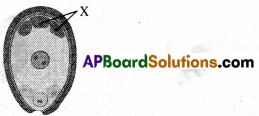
A) Egg cell
B) Antipodals
C) Polar nuclei
D) Synergids
Answer:
B) Antipodals
Question 157.
In this figure, X indicates ………[ ]
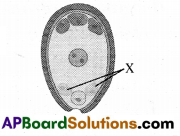
A) Antipodals
B) Polar nuclei
C) Synergids
D) Egg cell
Answer:
C) Synergids
![]()
Question 158.
In this figure X represents [ ]
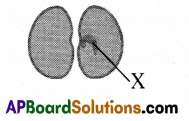
A) Cotyledon
B) Radicle
C) Plumule
D) Nuclei
Answer:
C) Plumule
Question 159.
In this figure, X represents [ ]
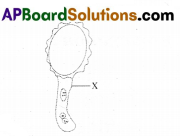
A) Plumule
B) Style
C) Stigma
D) Pollen tube
Answer:
D) Pollen tube
Question 160.
In this figure, X denotes …… [ ]

A) Garnet ophyte cells
B) Embryo sac
C) Style
D) Ovary
Answer:
B) Embryo sac
Question 161.
This is an example for [ ]

A) Bisexual flower
B) Unisexual flower
C) Sterile flower
D) None
Answer:
B) Unisexual flower
Question 162.
This is an example for [ ]

A) Bisexual flower
B) Unisexual flower
C) Sterile flower
D) None
Answer:
A) Bisexual flower
Question 163.
In this diagram, X represents [ ]

A) Calyx
B) Corolla
C) Style
D) Stamen
Answer:
C) Style
Question 164.
In this diagram, X represents [ ]

A) Anther
B) Style
C) Stamen
D) Ovary
Answer:
C) Stamen
Question 165.
In this diagram, X denotes [ ]

A) Anther
B) Stamen
C) Style
D) Ovary
Answer:
A) Anther
![]()
Question 166.
In this diagram, X represents the following.
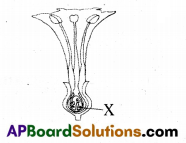
A) Stamen
B) Style
C) Ovary
D) Anther
Answer:
C) Ovary
Question 167.
Can you identify who I am?

A) Foetus
B) Zygote
C) Human embryo
D) Fish embryo
Answer:
C) Human embryo
Question 168.
Name the system that is shown in the diagram

A) Male reproductive system
B) Male nervous system
C) Female excretory system
D) Female reproductive system
Answer:
D) Female reproductive system
Question 169.
In the given diagram X denotes [ ]

A) Funnel
B) Vagina
C) Cervix
D) Fallopian tube
Answer:
D) Fallopian tube
Question 170.
In this diagram X represents
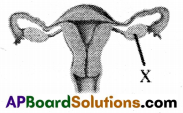
A) Fallopian tube
B) Cervix
C) Vagina
D) Ovary
Answer:
D) Ovary
Question 171.
Can you identify the system shown in the diagram? [ ]
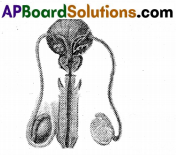
A) Female nervous system
B) Male excretory system
C) Female reproductive system
D) Male reproductive system
Answer:
D) Male reproductive system
Question 172.
In this diagram X represents [ ]

A) Testis
B) Penis
C) Prostrate gland
D) Epididymis
Answer:
D) Epididymis
Question 173.
In this diagram X denotes ….. [ ]

A) Testis
B) Epididymis
C) Prostrate gland
D) Urethra
Answer:
B) Epididymis
Question 174.
In the given diagram X represents [ ]

A) Testis
B) Prostrate gland
C) Seminal ducts
D) Penis
Answer:
C) Seminal ducts
![]()
Question 175.
In the given diagram X represents [ ]
![]()
A) Mitochondria
B) Acrosome
C) Middle piece
D) Tail
Answer:
B) Acrosome
Question 176.
Name the structure that denotes ‘X’ in the given diagram.

A) Middle piece
B) Acrosome
C) Tail
D) Mitochondria
Answer:
D) Mitochondria
Question 177.
Match the following.
List – A —- List – B
1) Kdible fungi [ ] a) Penicillium
2) Medicinal fungi [ ] b) Rhizopus
3) Bread mould [ ] c) Mushroom
A) 1 – a, 2 – b, 3 – c
B) 1 – a, 2 – c, 3 – b
C) 1 – c, 2 – b, 3 – a
D) 1 – c, 2 – a, 3 – b
Answer:
D) 1 – c, 2 – a, 3 – b
Question 178.
Can you name this method of artificial propagation?
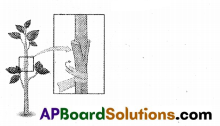
A) Layering
B) Cutting
C) Grafting
D) Tissue culture
Answer:
C) Grafting
Question 179.
What method of artificial propagation is going on in this plant: ……………

A) Cutting
B) Layering
C) Grafting
D) Tissue culture
Answer:
B) Layering
![]()
Question 180.
Can you name this method of artificial propagation? [ ]

A) Grafting
B) Layering
C) Cutting
D) None
Answer:
C) Cutting
Question 181.
Match the following.
List-A —- List-B
1) Cutting [ ] a) Nerium
2) Layering [ ] b) Mango
3) Grafting [ ] c) Rose
A) 1 – c, 2 – b, 3 – a
B) 1 – b, 2 – c, 3 – a
C) 1 – a, 2 – b, 3 – c
D) 1 – c, 2 – a, 3 -b
Answer:
D) 1 – c, 2 – a, 3 -b
Question 182.
This is the example for …………….

A) Corms
B) Stolon
C) Tuber
D) Bulb
Answer:
B) Stolon
Question 183.
This is the example for [ ]

A) Bulb
B) Stolon
C) Cornis
D) Tuber
Answer:
D) Tuber
Question 184.
This is the best example for [ ]

A) Stolon
B) Tuber
C) Corms
D) Root
Answer:
C) Corms
Question 185.
Identify then is matched pair. [ ]
1) Tuber-Potato
2) form – Golocasia
3) Bulb – Ginger
A) 1,2
B) 1,3
C) 1 only
D) 3 only
Answer:
D) 3 only
![]()
Question 186.
What is this process occurring in planaria? [ ]

A) Fragmentation
B) Binary fission
C) Regeneration
D) Budding
Answer:
C) Regeneration
Question 187.
This is the best example for [ ]

A) Regeneration
B) Fragmentation
C) Budding
D) Farthenogenesis
Answer:
A) Regeneration
Question 188.
What process is going on in spirogyra in the shown diagram? [ ]

A) Regeneration
B) Fission
C) Budding
D) Fragmentation
Answer:
D) Fragmentation
Question 189.
Can you name the given mode of asexual reproduction shown in the diagram? [ ]
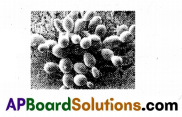
A) Fission
B) Fragmentation
C) Regeneration
D) Budding
Answer:
D) Budding
Question 190.
Can you name this mode of asexual reproduction? [ ]

A) Budding
B) Parthenogenesis
C) Regeneration
D) Fission
Answer:
D) Fission
Question 191.
Can you identify this phase of mitosis?

A) Prophase
B) Metaphase
C) Anaphase
D) Telophase
Answer:
B) Metaphase
Question 191.
Name the phase of mitosis shown in the diagram. [ ]

A) Anaphase
B) Metaphase
C) Telophase
D) Prophase
Answer:
A) Anaphase
Question 192.
Name the process shown in the given diagram. [ ]

A) Mitosis
B) DNA Replication
C) Crossing over
D) Meiosis
Answer:
D) Meiosis
Question 193.
This is the logo of [ ]

A) NCC
B) NGC
C) Scouts
D) Red Ribbon Club
Answer:
D) Red Ribbon Club
Question 194.
What contraceptive device do you see in the given diagram? [ ]

A) Condom
B) Copper-T
C) Spermicide
D) None
Answer:
B) Copper-T
![]()
Question 195.
Arrange the flow chart in the correct order. [ ]

A) 2,5,34,1
B) 2,1,5,3,4
C) 2,5,1,4,3
D) 2,5,1,3,4
Answer:
D) 2,5,1,3,4
Question 196.
Complete this flow chart. [ ]
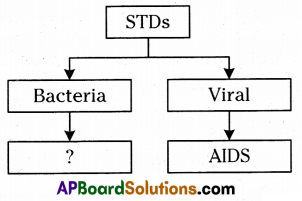
A) Syphilis
B) Gonorrhoea
C) Typhoid
D) A and B
Answer:
D) A and B
Question 197.
Complete this table.
| Before fertilization | After fertilization |
| 1) Ovule 2) Ovary |
Seed ? |
A) Carpel
B) Fruit
C) Endosperm
D) Seed coat
Answer:
B) Fruit
Question 198.
ASHA workers are associated with …………… [ ]
A) PHC
B) Anganwadi
C) Social Works
D) AIDS
Answer:
D) AIDS